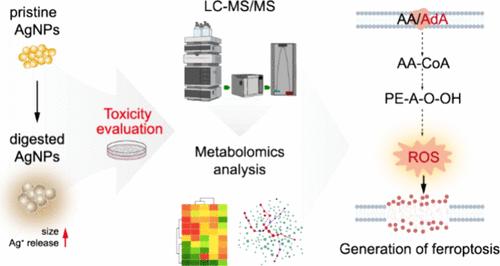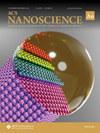利用体外胃肠道消化模型进行代谢组学分析以揭示银纳米粒子的毒理机制
IF 6.3
Q2 NANOSCIENCE & NANOTECHNOLOGY
引用次数: 0
摘要
随着银纳米粒子(AgNPs)在消费品中的使用日益增多,人们开始担心口腔接触银纳米粒子后会因其在胃肠道(GIT)中的转化和吸收而带来潜在的健康风险。然而,胃肠道错综复杂的状况给了解 AgNPs 从口腔到直肠的转归和毒性带来了挑战。为了深入了解纳米生物之间的相互作用,我们采用了模拟消化模型来研究 AgNPs 在体外的理化性质变化。同时,我们还通过代谢组学分析研究了消化后的 AgNPs 在肠细胞中的潜在毒性机制。与主要采用盐溶液模拟膳食消化的途径不同,该体外模型是一个半动态的顺序消化系统,包括人工口腔液、胃液和肠液,与生理条件下的消化系统相似,包括电解质、酶、胆汁、pH 值和消化时间。我们的结果表明,在模拟消化模型中形成的 Ag-Cl 和 Ag-S 物种可导致消化的 AgNPs 尺寸增大,酸性条件可促进 Ag+ 从颗粒中释放出来。更关键的是,消化酶和高浓度盐的存在增强了人类结肠肠细胞对Ag的吸收,最终促进了ROS的生成并加剧了细胞毒性。代谢组学分析进一步揭示,依次被消化的 AgNPs 可能会扰乱脂质代谢,包括不饱和脂肪酸的生物合成和花生四烯酸代谢,从而增加肠细胞铁突变激活的可能性。这些发现为了解 AgNPs 在消化道中的转归和潜在不良影响提供了重要启示,为评估 AgNPs 通过口服暴露对健康造成的风险提供了重要意义。本文章由计算机程序翻译,如有差异,请以英文原文为准。

Metabolomics Analysis for Unveiling the Toxicological Mechanism of Silver Nanoparticles Using an In Vitro Gastrointestinal Digestion Model
The increasing use of silver nanoparticles (AgNPs) in consumer products has led to concerns about potential health risks after oral exposure as a result of the transformation and absorption in the gastrointestinal tract (GIT). However, the intricate condition of the GIT poses challenges in understanding the fate and toxicity of AgNPs as they traverse from the mouth to the rectum. For an in-depth understanding of the nanobio interactions, we employed a simulated digestion model to investigate alterations in the physicochemical properties of AgNPs in vitro. Meanwhile, we investigated the underlying toxicological mechanisms of digested AgNPs in enterocytes through metabolomics analysis. In contrast to route means that primarily apply salt solutions to mimic dietary digestion, this in vitro model is a semidynamic sequential digestion system that includes artificial oral, gastric, and intestinal fluids, which are similar to those under physiological conditions including electrolytes, enzymes, bile, pH, and time of digestion. Our results suggest that the formation of Ag–Cl and Ag–S species within the simulated digestion model can lead to an increase in the size of digested AgNPs and that the acidic condition promotes the release of Ag+ from particles. More critically, the presence of digestive enzymes and high concentrations of salt enhances the uptake of Ag by human colon enterocytes, ultimately promoting ROS generation and exacerbating cytotoxicity. Metabolomics analysis further reveals that the sequentially digested AgNPs may disorder lipid metabolism, including the biosynthesis of unsaturated fatty acids and arachidonic acid metabolism, thus increasing the possibility of ferroptosis activation in enterocytes. These findings offer significant insights into the fate and potential adverse effects of AgNPs in the GIT, providing important implications for assessing the health risks of AgNPs via oral exposure.
求助全文
通过发布文献求助,成功后即可免费获取论文全文。
去求助
来源期刊

ACS Nanoscience Au
材料科学、纳米科学-
CiteScore
4.20
自引率
0.00%
发文量
0
期刊介绍:
ACS Nanoscience Au is an open access journal that publishes original fundamental and applied research on nanoscience and nanotechnology research at the interfaces of chemistry biology medicine materials science physics and engineering.The journal publishes short letters comprehensive articles reviews and perspectives on all aspects of nanoscience and nanotechnology:synthesis assembly characterization theory modeling and simulation of nanostructures nanomaterials and nanoscale devicesdesign fabrication and applications of organic inorganic polymer hybrid and biological nanostructuresexperimental and theoretical studies of nanoscale chemical physical and biological phenomenamethods and tools for nanoscience and nanotechnologyself- and directed-assemblyzero- one- and two-dimensional materialsnanostructures and nano-engineered devices with advanced performancenanobiotechnologynanomedicine and nanotoxicologyACS Nanoscience Au also publishes original experimental and theoretical research of an applied nature that integrates knowledge in the areas of materials engineering physics bioscience and chemistry into important applications of nanomaterials.
 求助内容:
求助内容: 应助结果提醒方式:
应助结果提醒方式:


